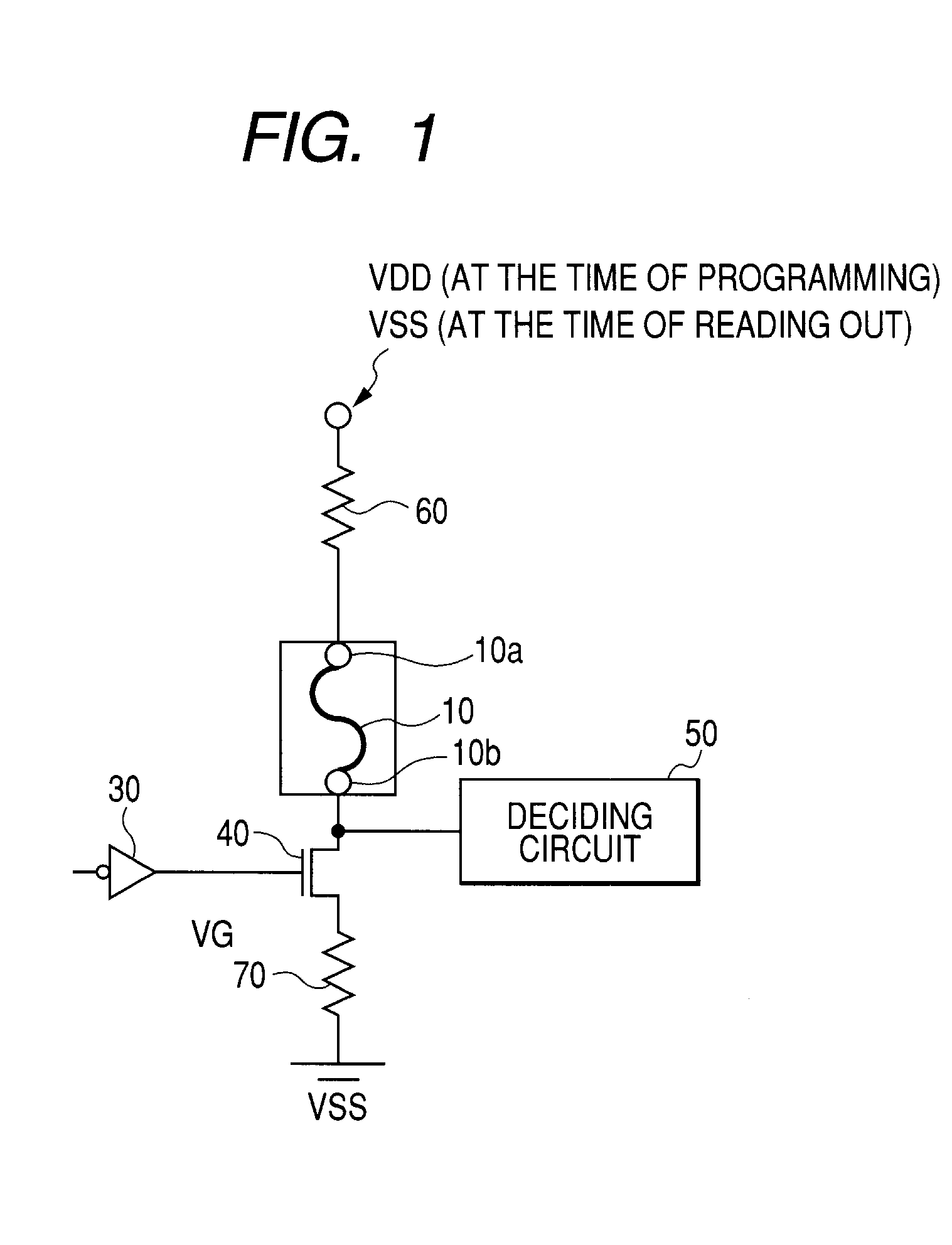Semiconductor device and a method of increasing a resistance value of an electric fuse
a technology of a semiconductor device and an electric fuse, which is applied in the direction of semiconductor devices, semiconductor/solid-state device details, electrical apparatus, etc., can solve the problems of damage to the structure around the electric fuse, and achieve the effect of increasing reducing the time required for an increase in the resistance of the electric fus
- Summary
- Abstract
- Description
- Claims
- Application Information
AI Technical Summary
Benefits of technology
Problems solved by technology
Method used
Image
Examples
embodiment 1
[0073]An electric fuse of an embodiment 1 of the present invention is not any electric fuse formed in the same layer in which a gate electrode is formed, as in the prior art. The electric fuse of the embodiment 1 is formed in a fine layer in a multi-layered structure including the fine layer, a semiglobal layer and a global layer in a semiconductor device. Therefore, the electric fuse is prevented from damaging its semiconductor substrate.
[0074]According to the structure of the semiconductor device of the embodiment 1, other elements, such as a transistor for controlling the flow of an electric current for increasing the resistance of the fuse, can be arranged in a space from the semiconductor substrate to the electric fuse; therefore, it is possible to make small the occupation area of elements arranged in a direction parallel to a main surface of the semiconductor substrate of the semiconductor device.
[0075]The increase in the resistance of the electric fuse of the embodiment 1 is...
embodiment 2
[0111]With reference to FIGS. 35 and 44, a method of an embodiment 2, wherein the resistance of an electric fuse is increased, is described herein. The electric fuse structure used in the embodiment 2 may be the same as in the embodiment 1.
[0112]In the embodiment 2, a method for cutting the electric fuse 10 described in the embodiment 1 more certainly is described. Specifically, described is a matter that it is necessary to adjust the rise time of electric pulses caused to flow into the electric fuse 10 in order to cut the electric fuse 10 more certainly.
[0113]When the electric fuse is cut, the temperature of the main wiring 1 needs to reach the melting point or a higher temperature. However, a phenomenon generated when the electric fuse 10 is cut is varied in accordance with the period from a time when a rise in the temperature of the main wiring 1 starts to a time when the temperature of the main wiring 1 reaches the melting point or a higher temperature. Accordingly, unless this ...
embodiment 3
[0135]With reference to FIGS. 45 to 47, a method of an embodiment 3, wherein the resistance of an electric fuse is increased, is described herein. The electric fuse structure in the embodiment 3 may be the same as in the embodiment 1.
[0136]In the case of using the method of increasing the resistance of an electric fuse according to each of the embodiments 1 and 2, the cracks 6 may not extend immediately in the insulator layer 4. This would be because a considerable large electric current cannot be caused to flow into the electric fuse 10 because of a problem resulting from the structure of the circuit and thus thermal stress generated in the electric fuse structure is not sufficiently large for generating the cracks 6. For this reason, the electric fuse 10 may not be cut by the cutting method described as the embodiment 1 or 2. Accordingly, a method for cutting the electric fuse 10 certainly in this case will be described hereinafter.
[0137]When an electric current is caused to flow ...
PUM
 Login to View More
Login to View More Abstract
Description
Claims
Application Information
 Login to View More
Login to View More - R&D
- Intellectual Property
- Life Sciences
- Materials
- Tech Scout
- Unparalleled Data Quality
- Higher Quality Content
- 60% Fewer Hallucinations
Browse by: Latest US Patents, China's latest patents, Technical Efficacy Thesaurus, Application Domain, Technology Topic, Popular Technical Reports.
© 2025 PatSnap. All rights reserved.Legal|Privacy policy|Modern Slavery Act Transparency Statement|Sitemap|About US| Contact US: help@patsnap.com



